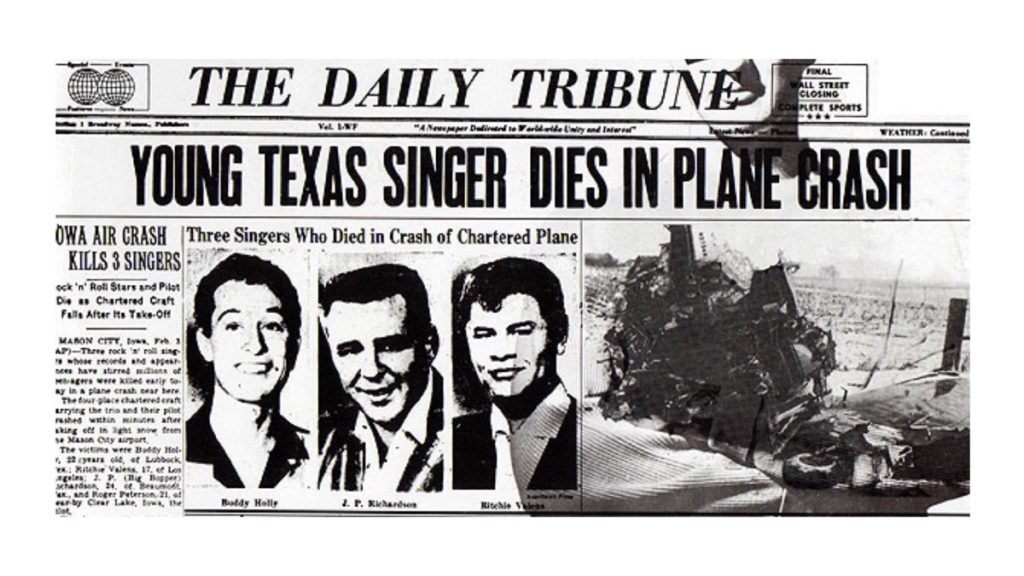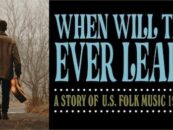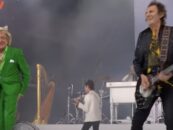‘The Day the Music Died’: 1st-Hand Recollections of Buddy Holly, Ritchie Valens and The Big Bopper
by Harvey KubernikFebruary 3 marks the anniversary of the tragic airplane crash that subsequently became known as “The Day the Music Died,” sadly referenced in Don McLean’s 1971 song, “American Pie.” Buddy Holly, Ritchie Valens and J.P. Richardson, aka The Big Bopper, died along with pilot Roger Peterson.
After a February 2, 1959, “Winter Dance Party” show in Clear Lake, Iowa, Holly, Valens and Richardson took off from the Mason City, Iowa, airport, in a three-passenger plane that Holly chartered, piloted by Peterson during inclement weather. It crashed into a cornfield just minutes after takeoff.
I will always remember the February 3, 1959, front page headline in The Los Angeles Times-Mirror, a daily newspaper that reported this accident.
Valens’ death was a very big regional loss in that area. He was from Pacoima, a suburb in Southern California. His records were very popular in Los Angeles and the surrounding communities. It was KFWB DJ Gene Weed who first spun his music and the radio station held what seemed like an all-day wake celebrating the life of Valens, whose record label, Del-Fi, was based in Hollywood.
“Chantilly Lace” by The Big Bopper, who was also a popular disc jockey in Texas, was a national hit.
The music and recorded catalog of Holly never really died, and the sonic legacy of Valens has continued. “Chantilly Lace” is constantly heard daily on oldies and classic rock radio stations. Richardson also wrote “White Lighting,” which George Jones recorded, and penned “Running Bear” for Johnny Horton. Richardson is in the Rockabilly Hall of Fame.
At various times, I asked two dear friends of mine, author/music historian Roger Steffens and the late multi-instrumentalist Chris Darrow, to share their memories of witnessing Buddy Holly and Ritchie Valens perform.
Roger Steffens: At Christmas 1957 I went to my first rock and roll show, Alan Freed’s giant Christmas Jubilee of Stars at the Paramount Theater on Times Square. The run broke all attendance records, including the previous best, a Frank Sinatra tour in 1944. My friends and I had to lie to our parents, because they were sure we would be mugged. So we told them we were going to Hackensack (N.J.) to see a movie, but got on the bus to the Port Authority instead and walked the few blocks to the Paramount, which had a line stretching three times around the block.
The show included Fats Domino, Jerry Lee Lewis, the Everly Brothers, Frankie Lymon and the Teenagers, Lee Andrews and the Hearts, Danny and the Juniors, the Dubs and eight others. Most of the second line performers got only one or two songs each, but Buddy Holly and the Crickets got five, because they were on the charts under both names at the time. They were all dressed in tuxedos, and played with a stand-up bass. The audience went wild for Buddy, clapping along with his rhythms, and singing along with his parade of hits.
I remember watching Alan Freed’s 5-6 pm Rock and Roll Party TV show on WABD, Channel 5, in New York City. He interviewed Buddy about the national tour they had done together in 1956, during which they flew in a small plane to get to a gig, and encountered severe turbulence. Buddy recalled the “woop-woop” as the plane fell and climbed and fell again. What a premonition! It was one of the saddest days of my youth when we learned of that terrible crash that took his life, and the first time I cried over the loss of a performer. Odd that one of the final releases during his short lifetime was “It Doesn’t Matter Anymore.”
Watch Buddy Holly and the Crickets perform “Peggy Sue” on The Ed Sullivan Show
Chris Darrow: I saw Ritchie Valens a month before his death, in Pomona (Calif.) at the Rainbow Gardens, an all-wooden building with a low ceiling that was later to burn to the ground. I was from a mixed-race white and Hispanic neighborhood in Claremont, called Arbol Verde. My best friend Roger Palos was Mexican, and he and I were both learning to play guitar and we would sing together a lot. The songs that we learned that were not from the folk music genre were popular songs mainly by Elvis Presley, the Everly Brothers, Buddy Holly and Ritchie Valens. For some reason our favorite song of Ritchie’s was not “La Bamba” or “Donna” but “Hi-Tone.” We just loved that song.
I was 15 and in the ninth grade and was not allowed to go out to many places by myself at night. I was attending a private school in Claremont, called Webb, which had sons of famous people in my class. Since I wasn’t driving yet, it took a lot for my folks to let me go into the dark part of Pomona to see a rock and roll show in 1959. My parents weren’t square but my mom always worried about me. I went with Roger Palos and Jon Dearborn to the concert, and it was kind of a pilgrimage for us. Since I really identified with the Mexican culture and wasn’t afraid, I couldn’t wait to see one of my main men, Ritchie Valens. After all, he was only 17 and not much older than Roger and me. I wore my bright, red corduroy coat with silver buttons that my grandma Darrow had made for me that Christmas. I also wore white bucks, white pants and red argyle socks. I looked sharp!
I’m not sure who the house band was, but it could have been Manuel and the Renegades, or the Mixtures, for they both used to be regulars at the Rainbow Gardens. I was very excited and hadn’t been to too many concerts before this. I listened to a lot of radio at the time and because of the heavy Mexican influence in my life, I got turned on to KDAY with Art Laboe, who would broadcast live from Scribner’s Drive-In, and Ol’ HH—Hunter Hancock—who had a great show called Harlem Matinee. These were the guys that the Mexicans listened to on the radio. I was also into KFWB, with Al Jarvis, Bill Balance and Ted Quillan, and Dick Hugg “Huggy Boy” on KGFJ. He was on so late at night that I would have to listen to him under the covers of my bed in my room. So what is now called doo-wop was big with me, as well as the white-dominated music so prevalent on major radio stations of the time. The Oldies but Goodies albums by Laboe on Original Sound were right up my alley.
I was really into dancing at the time and had a chance to dance a few numbers with some strangers at the show. The opening act for Ritchie was Jan and Dean; possibly really Jan and Arnie. In those days no one had their own bands and acts would use house bands as their own. Either the band didn’t like Jan and Dean or they just didn’t care. Before they could get through the first song, which sounded awful, Jan stopped, ran off the stage followed by Dean, and plowed through the locked stage door and out into the night. Jan just kicked it open like some thug in a movie. I was so shocked and dumbstruck by this. They never came back.
After the commotion died down, it was time for Ritchie to come on. He whirled in, probably from some other gig earlier that night, and I went right up next to the edge of the stage. He was a pretty big guy and loomed onstage with a graceful power. He was not overtly hardcore in his presentation but was very soulful and I ate it up. There was a tenderness and sweetness about him, even as he rocked. The house band knew his stuff and did a great job on the songs. He did “La Bamba” and “Donna” and even played my favorite song, “Hi-Tone.”
Watch Ritchie Valens mime “Ooh My Head”
I liken Ritchie to another L.A. guy, Eddie Cochran. Both had the soul and drive of the Sun/Clovis, New Mexico, records, but they were from our own backyard. As soon as Ritchie finished, he was whisked off in a flash. There was no chance to say hello or offer a handshake, but I was ecstatic over the event. The house band played on to people doing the Stomp and I was awarded a prize for being one of the five best-dressed guys of the night. A perfect end to a perfect evening.
I read somewhere that Frank Zappa saw Ritchie in Pomona, so he was probably there, too. A month after the gig I was at school and heard about the deaths of Ritchie, Buddy and the Big Bopper. I was crushed and went off by myself and cried like a baby. It was the first time I remember crying for someone who had died. Ritchie Valens and Buddy Holly were like gods to me at the time and could do no wrong. It was one of the great losses in rock and roll history.”
Listen to the song that tells the story…
Related: The legacy of Buddy Holly
Author and music journalist Harvey Kubernik’s books are available here.








6 Comments so far
Jump into a conversationbuddy holly lives….the best ever
I saw them in Green Bay, Wi. at the Riverside ballroom a few days before.
You are so fortunate to have attended one of the Winter Dance concerts. What a blessing for you!
Buddy’s music never dies. We all know most of his songs, no matter what our age.
Future generations will continue to do so.
Tragic loss. It’s amazing to see how talented Ritchie was at 17
After the Surf Punks I worked for Gary Busey. Got to play Buddy Holly’s guitar. I’ve tried to get hold of Harvey K. for decades now. It’s easier to get hold of the Pope. I have video of him backstage at our show at the civic. Goddard (RIP) too. Dragon (RIP) too.